* (restored)

‘Internationally lauded “explosives artist” Cai Guo-Qiang has already amassed some stunning stats: He may be the only artist in human history who has had some one billion people gaze simultaneously at one of his artworks. You read that right, one billion. I’m talking about the worldwide televised “fireworks sculpture” that Cai Guo-Qiang—China-born, living in America now—created for the opening of the Beijing Olympics in 2008. If you’re one of the few earthlings who hasn’t seen it, either live or online, here’s Cai’s description: “The explosion event consisted of a series of 29 giant footprint fireworks, one for each Olympiad, over the Beijing skyline, leading to the National Olympic Stadium. The 29 footprints were fired in succession, traveling a total distance of 15 kilometers, or 9.3 miles, within a period of 63 seconds.”
‘But a mere billion pairs of eyes is not enough for Cai’s ambition. He’s seeking additional viewers for his works, some of whom may have more than two eyes. I’m speaking of the aliens, the extraterrestrials that Cai tells me are the real target audience for his most monumental explosive works. Huge flaming earth sculptures like Project to Extend the Great Wall of China by 10,000 Meters, in which Cai detonated a spectacular six-mile train of explosives, a fiery elongation of the Ming dynasty’s most famous work. Meant to be seen from space: He wants to open “a dialogue with the universe,” he says. Or his blazing “crop circle” in Germany, modeled on those supposed extraterrestrial “signs” carved in wheat fields—a project that called for 90 kilograms of gunpowder, 1,300 meters of fuses, one seismograph, an electroencephalograph and an electrocardiograph. The two medical devices were there to measure Cai’s physiological and mental reactions as he stood in the center of the explosions, to symbolize, he told me, that the echoes of the birth of the universe can still be felt in every molecule of every human cell.
‘As a youth, he says, “I was unconsciously exposed to the ties between fireworks and the fate of humans, from the Chinese practice of setting off firecrackers at a birth, a death, a wedding.” He sensed something in the fusion of matter and energy, perhaps a metaphor for mind and matter, humans and the universe, at the white-hot heart of an explosion. By the time of the political explosion of Tiananmen Square in 1989, Cai had left China and was in Japan, where “I discovered Western physics and astrophysics.” And Hiroshima.
‘The revelation to him about Western physics, especially the subatomic and the cosmological Big Bang levels, was that it was somehow familiar. “My Taoist upbringing in China was very influential, but not until I got to Japan did I realize all these new developments in physics were quite close to Chinese Qi Gong cosmology. The new knowledge of astrophysics opened a window for me,” he says. The window between the mystical, metaphorical, metaphysical concepts of Taoism—the infinity of mind within us and that of the physical universe whose seemingly infinite dimensions outside us were being mapped by astrophysicists. For example, he says, “The theory of yin and yang is paralleled in modern astrophysics as matter and antimatter, and, in electromagnetism, the plus and minus.”
‘Maybe there’s the sly wink of a showman behind these interspatial aspirations, but Cai seems to me to be distinctive among the current crop of international art stars in producing projects that aren’t about irony, or being ironic about irony, or being ironic about art about irony. He really wants to paint the heavens like Michelangelo painted the Sistine Chapel ceiling. Only with gunpowder and flame.’ — The Smithsonian
___
Stills

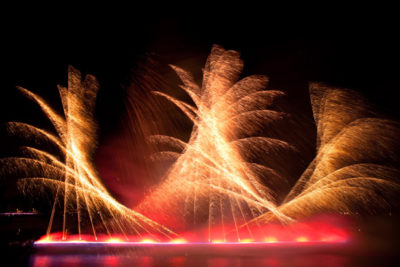







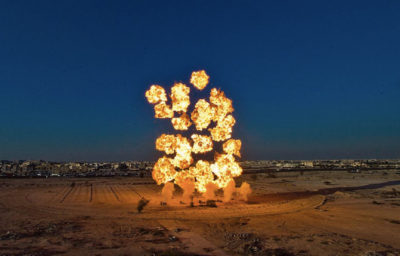











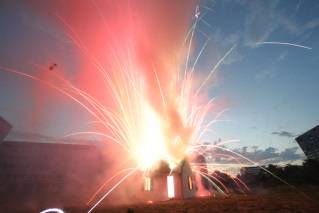
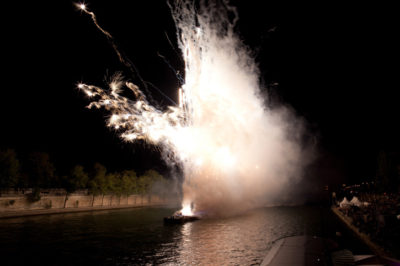
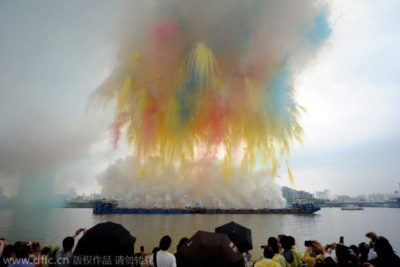
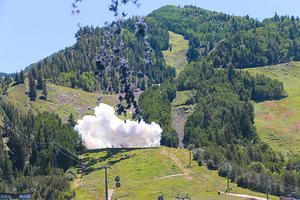
_____
Further
Cai Guo-Qiang Website
Video: Cail Guo-Qiang @ PBS
‘Why Cai Guo-Qiang Is Good For China And Bad For Art’
‘Meet the Artist Who Blows Things Up for a Living’
Cai Guo-Qiang Studio Blog
Cai Guo-Qiang @ Facebook
‘Contextualizing Cai Guo-Qiang’
‘Cai Guo-Qiang Explodes Onto Soho Real Estate Scene’
‘Playing with fire’
‘Cai Guo-Qiang, Move Along, Nothing to See Here’
‘An Encounter With Cai Guo-Qiang, The World’s Foremost Explosion Artist’
‘Gunpowder Plots’
____
Extras
Cai Guo-Qiang Explosion Work
‘Body Scan’: 2013 Cai Guo-Qiang Interview
Cai Guo-Qiang at Guggenheim Museum New York
cai guo-qiang with wu yulu: robot imitating damien hirst
_______
Interview
from Cool Blog English

Where do you find themes for your works?
Cai Guo-Qiang: After the 9/11 attack in New York, my themes and works has been quite diverse. For example, I made the rainbow of fireworks above the East River and expressed the colorfulness of the city. I also made the black rainbow under the daylight, whose theme was to express the dismay of the modern society. The pieces with cars inspired me to produce pieces about terrorist attacks.
You have works which have concepts of Feng Shui. Do you arrange your studio according to Feng Shui?
Cai Guo-Qiang: Absolutely. Feng Shui is the first priotiry when choosing studios. Even after choosing the studio, I rely on Feng Shui where to place Buddha and other stuff. I placed the Lion Rock between doors. I have many female staffs, and when they complained that they were too busy with work to date, I placed some stuff that would bring opportunities to meet great matches. I also made a Japanese-style garden in the studio. At exhibitions at local towns, Feng Shui represents the energies of the culture, people’s history, and space of the town. The life energy “Qi” is an invisible energy. I develop ideas and work on my pieces, taking that energy highly into consideration. I don’t always express like “This is Feng Shui” in my works directly, but when I am working, I am conscious of Feng Shui in an invisible way, like aesthetically.
Upon the production of your works in which you use gunpowder, you invented the technique to control the altitude of explosions of fireworks by putting microchips into firework balls. How did the invention affect your work after adopting microchips?
Cai Guo-Qiang: First, it had been said that using gunpowder was dangerous. Until I started developing the technique of built-in microchips around 2001, all the fireworks were exploded by fuse and the timing of explosions were calculated by the length of fuse. Since fuse was made by hand, it was very difficult to fix the shape and order of explosions of fireworks. But if you use fireworks with built-in microchips, the altitudes and timing of explosions are already calculated.For instance, it is like 2000 people who have tickets get seated exactly in their right seats. I can control the altitude and timing of the explosions of 2000 fireworks. However, there are a good thing and a bad thing about introducing microchips. The good thing is that now I can use the sky as canvas. The bad thing is that they are expensive. I feel pressured in many aspects because huge amount of money is spent on few dozens of seconds of art. That is, promoters try to gather many people to see that expensive piece of art by using the media. The pressure gets even more intense when thousands of people come to see the few dozen seconds of art. That kind of pressure is basically nothing to do with arts, though. Now that I can collect funds and attract people for my work, but I still feel apprehensive if that something in the sky was an art and that the piece was really an artistic piece.
When do you feel the excitement while working?
Cai Guo-Qiang: All the time. I always joke that making pieces is the same thing as having sex (laughs). Even when you fail, you can’t start over again. Each time is the last time, and you never know if it will end up good or bad if you don’t try. But when I finish working, all I feel is a joy. No matter good or bad. I always feel delighted and happy after completing my works.
What is an art for you?
Cai Guo-Qiang: An art is what I do. Through the artistic eyes, everything in the world, from election campaigns of politicians or constructions on the streets, can look as arts.
If you were not an artist, what do you think you would be doing?
Cai Guo-Qiang: I can’t imagine. I can’t see myself being anything but an artist. Sometimes I myself think that I am good at making artistic pieces, but I am not that good at anything else.
____
Show
Mystery Circle, MOCA Los Angeles, 2012
‘Wait — he’s shooting the fireworks at us? That was the general worry Saturday night as Chinese artist Cai Guo-Qiang readied his explosion show outside the Geffen Contemporary at MOCA. After all, fireworks should go up, vertical, away from people — not toward them. But Cai didn’t get his reputation as a world-renowned pyro-wiz by doing what’s expected. “Mystery Circle,” Saturday’s event, would be no exception. Around 7:40 p.m., the sky rapidly darkening, the two-minute warning was given, then it was one minute, 30 seconds, 10 seconds, a spirited countdown — and boom. Some 40,000 rockets, arranged on the northern wall of the Geffen Contemporary in a crop circle-like pattern, exploded outward in a massive display of light, heat and sound.’ — LA Times
City of Flowers in the Sky, Florence, 2018
‘Cai Guo-Qiang brought his daytime firework display to Florence this weekend as he launched 50,000 fireworks over the historic Italian city. Shrouding this scenic corner of Tuscany in colorful smoke, Cai’s 10-minute long work was entitled ‘City of Flowers in the Sky’ and was comprised of seven separate movements: “Thunder,” “God of the West Wind and Goddess of the Land”, “The Birth of Flora”, “Venus”, “Three Graces”, “Spiritual Garden” and “Red Lily”.’ — RADII
Black Ceremony, Hiroshima, 2008
‘The City of Hiroshima has selected the winner of the 7th Hiroshima Art Prize, contemporary artist Mr. Cai Guo-Qiang (born 1957 in Fujian Province, China, currently resident in New York). Cai Guo-Qiang has created a great number of pieces that are not only based on a unique vision of the universe rooted in traditional Chinese culture and thought but his art offers a penetrating view of human history and civilization. In his outdoor project in Hiroshima, both a celebration of the rebirth of Hiroshima and a requiem, Cai was able to use his personal methodology of using gunpowder to raise questions regarding not only the historical significance of Hiroshima but also the physical phenomenon of the A-bomb.’ — city.hiroshima.jp
Tornado, Washington, D.C., 2005
‘Washington will be treated to a state-of-the-art pyrotechnics event along the Potomac River, created exclusively for the opening of the festival by artist Cai Guoqiang, who has stunned onlookers from New York to Shanghai. Called an “Explosion Event” by the artist, his spectacular display will incorporate beautifully choreographed traditional fireworks, basic primordial gunpowder and fuse, and high-tech computer-chip embedded firework shells to ignite dancing boats, floating kites, and flying fire dragons–as well as an awesome tornado spiraling across and punctuating the sky.’ — china.org
Black Ceremony, Qatar, 2011
‘At the Arab Museum of Modern Art in Doha, Qatar this week, Chinese artist Cai Guo-Qiang put on his largest “explosion event” of the last three years, utilizing microchip-controlled explosives to form incredible designs and patterns. The video we’ve embedded of the event is an impressive testament to how a volatile black powder explosion can be controlled and shaped by computer.mEach set of explosions was calculated to paint a different picture. One series of explosions created black smoke clouds that looked like “drops of ink splattered across the sky.” In another, 8,300 shells embedded with computer microchips exploded in a pyramid shape over the desert.’ — Nate Mook
Black Christmas Tree, Washington, D.C., 2012
‘Just in time for Christmas, Cai Guo-Qiang has brought his pyrotechnics skills back to America. Commissioned by the Arthur M. Sackler Gallery at the Smithsonian in Washington DC, the renowned Chinese contemporary artist executed three separate explosions in a performance entitled Black Christmas Tree described as acupuncture treatment for arts in the city. Surprisingly, the tree is still alive post-detonation and will be re-planted elsewhere.’ — Arrested Motion
Simulated Demolition, Taiwan, 1998
‘A simulated demolition by fire of the Taichung (Taiwan) National Gallery of fie Arts (1980), as it reopens in modernist carapace in 1998. The incendiation seems meant to be a celebration of the re-architecturing and change in focus of exhibitions: Destruction” opening the way for “Construction”.’ — asianimperialisms.com
Fallen Blossoms, Philadelphia, 2009
‘Fallen Blossoms consists of a poetic meditation on the passing of time, memory, and memorializing. One of the artist’s signature “explosion events,” Fallen Blossoms: Explosion Project was specifically commissioned for the exhibition and occurred at the Philadelphia Museum of Art; followed by a second explosion event at the Fabric Workshop and Museum. It took place at sunset on Friday, December 11 on the East Terrace of the Philadelphia Museum of Art, where a blossoming flower shaped from gunpowder fuse was ignited.’ — dissidents.com
Black Rainbow, Valencia, 2005
‘Cai Guo-Qiang conceived Black Rainbow: Explosion Project for Valencia as part of a series of salutes that will take place in cities across the world (Black Rainbows are also scheduled for Edinburgh and Beijing). Black Rainbow is unique as a project sited in multiple venues. The repetition of Black Rainbow in the international community is intended as a series of omens of widespread unease. While signaling alarm like ancient smoke signals, the ominous arc of smoke in Black Rainbow also serves as a somber and dreamlike salute and reminds us, despite our contemporary associations with explosive materials and warfare, that violence and its signifiers can possess ethereal and profound beauty.’ — Culturebot
New Years Fireworks, Taipei, 2011
‘2011 was a special celebration for Taipei, the new year saw in the Centennial of the Republic of China’s (Taiwan) founding in 1911, and to celebrate, China’s Cai Gui-Qiang was commissioned to choreograph a special fireworks display. The superstar artist who’s has previously worked on displays for the Beijing Olympics and World Expo Shanghai’s, and fireworks are very much of the artists method of work, in his iconic ‘Gunpowder Paintings’.’ — slamxhype.com
Explosion Event, Copenhagen, 2012
‘For Faurschou Foundation’s inaugural exhibition, Cai Guo-Qiang has referenced the foundation’s new location in the Free Port of Copenhagen, as well as the country’s historical and cultural connection to the sea. On the day of the opening, Cai ignited thousands of mini rockets from a small traditional Danish boat ‘Freja’ on the water behind the foundation, in front of an enthusiastic crowd from all over Denmark and beyond. The scorch marks from the explosion transformed the boat into a three-dimensional gunpowder drawing, and this sculpture subsequently becomes a part of the exhibition.’ — faurschou.com
Elegy, Shanghai, 2014
‘Cai’s work in front of the Power Station of Art in Shanghai, China is eight minutes of colors filling the sky, in a ritualistically sincere elucidation of the ‘death of nature’. The show personifies the natural world with remembrance, looking back on the past and the transitory nature of time through a display of colorful smoke. The smoke fades away until nothing is left, no reminiscence of the beauty that once was, just like everything that exists in nature. The police asked the artist not to publicize the event to prevent traffic problems. The fireworks left many people clueless, thinking that the massive, yellow and black-and-green clouds were the toxic results of a serious accident. Aware of recent, non-artistic explosions (factory in Jiangsu3, gas pipes in Kaohsiung4, both in 2014), widely publicized in the Chinese media, concerned locals started calling the police.’ — Public Delivery
*
p.s. Hey. ** David Ehrenstein, Indeed. Ah, … Everyone, Mr. Ehrenstein marked the occasion of MLK’s b’day, and continues to mark it, via a small but potent thing on his FaBlog called Shall We Overcome?. Les Mots à La Bouche is, yes, being forced to try to relocate. I don’t think they’ve had luck in that regard so far. It is a grim thing. That shop has been a Marais cornerstone for forever. Fingers crossed. Jean-Paul Gaultier has been out of inspiration for a very long time, so it’s about time he took his bow. Yury’s interest in fashion has waned quite a lot. He works in real estate now. ** Misanthrope, Yes, day off, and you appropriately took your days off, which seems respectful, really. Did you manage to reengage with the matters at hand however? I haven’t noticed a similar slowness here. Well, the metro being on the fritz causes movement to and fro to happen at a more leisurely place, if that counts. ** _Black_Acrylic, My pleasure, of course. I’ll go look at Katy Dove’s work. I don’t believe I know it. Happy day to you. ** Steve Erickson, I would really doubt ‘The Grand Bizarre’ will get a theater release at this point, but I can totally imagine it will have a healthy life via streaming. I did read that about Hatari. I haven’t listened. They seem like a thing whose charm was pretty much dependent on it happening in a very shallow context, but who knows. ** Corey Heiferman, Hi, Corey. I hope you enjoy your delve. Glad you have conquered things that were beasts. For me, coffee is a borderline muse and a dear friend of my creativity. Here’s hoping that job pans out, obviously. I’m just a never ending tourist here with no bank account or anything, so I don’t pay taxes in this country, and barely in my (former) own. But I get it. New, me? Not a ton. Waiting on the ARTE decision. The gallery show partly featuring my GIF works opens on Thursday, and that’s new. Still waiting for a US publisher for my new novel, but that’s definitely not new. Trounce your Tuesday! ** Okay. I’ve revived this formerly dead post featuring the explosions of fireworks auteur Cai Guo-Qiang, and it’s packed with fun and weird beauty, so you guys should have a good time around here today if you’re so inclined. See you tomorrow.




 Now available in North America
Now available in North America 
Yury in Real Estate? What a concept! Hope it’s working out for him. Fashion, I fear, is on life supports. The outfits worn at this year’s award shows in Hollywood have been vomit-provoking. Mr.s Vreeland is turning over in her grave!
Dennis! So excited, had to tell you. I got a new laptop and spent all weekend setting it up. But the one thing that wouldn’t work was the DVD player, so I tried downloading a different player today – and it worked, finally, after 3 player attempts. And guess what DVD I got running – Like Cattle Towards Glow, of course! My players have always loved that film, haha. Showed the first scene to a neighbor and he loved it. Of course, I knew he would. Always good to have you in sync with my DVD success. 🙂
In these videos of Cai Guo-Qiang artworksc I really like the woops and hollers from the crowd. I think the audience reaction is often the most interesting part of a fireworks display.
I get the feeling Hatari peaked with Eurovision, but who knows? I do find that their music loses a great deal without their visuals.
This week, I am gonna make a big push to find new writing outlets. I’m really dreading this.
Dennis, I did. Got on the novel and did some good work yesterday evening.
So I’m thinking people going so leisurely/slow because either 1. they’re exhausted and feel a heaviness, or 2. they’re calm and comfortable and content and relaxed. Or 3. I’m just running into some really slow people at random.
Two funny things happened to me today. I made my coffee in the morning for my ride to work…and forgot to put the carafe under it. Yep, all over the fucking counter and had to redo it. Then at work, this fucking dude asked me if I was 55. I’m like, no, I’m 48…55? Get the fuck out of here. 😀
Great post, Dennis. Really enjoyed the visual beauty of Cai Guo-Qiang as well! Just read ‘L’Incal’ by Jodorowsky and Moebius – have you read it? Before that I read Jim Goad’s, ‘The Bomb Inside my Brain’. My friend got it for me as a gift and I wasn’t expecting to enjoy it that much – although I did absolutely love ‘Answer Me!’ – but I was pleasantly surprised! He’s relaxed a bit with age (and fatherdom, I guess). his writing is better for it. Glad ‘The Dregs trilogy’ arrived safe and sound! Scotland loves you, mate!